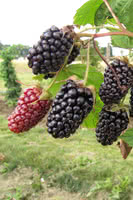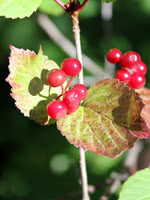Mon-Fri 9am - 5pm Mountain time
Lowbush Cranberry vs Chester Thornless Blackberry
Rubus fruticosa Chester (Thornless)
Viburnum edule
NOT AVAILABLE THIS SEASON - MIGHT RETURN
(new stock expected: fall of 2026)
NOT AVAILABLE THIS SEASON - MIGHT RETURN
Chester Thornless Blackberry is a self-pollinating fruit-bearing shrub. In mid-summer, the Chester Thornless Blackberry produces large, sweet-tasting, heart-shaped blackberries that are perfect for fresh eating. It is a semi-erect blackberry plant that requires little support from a trellis to keep its fruit off the ground. Don't forget to protect your berries. The birds love this shrub almost as much as you will.
Chester Thornless Blackberries are floricanes, primarily fruiting on second year canes. Each spring cut back all two-year old canes, leaving only the last year’s growth.
Lowbush Cranberry is a short, deciduous shrub native to North America. Its white flowers bear sour but edible fruit that ripens to a brilliant red in fall. Lowbush Cranberry's small size makes it suitable for urban use; buyers will also find it useful if trying to reclaim land back to its original species or when landscaping with native species in damp conditions.

